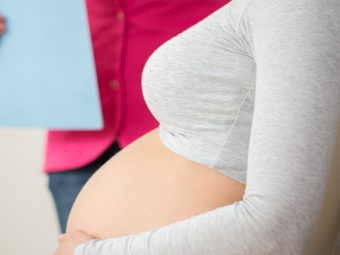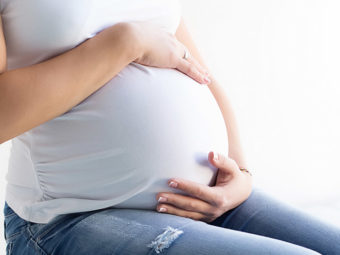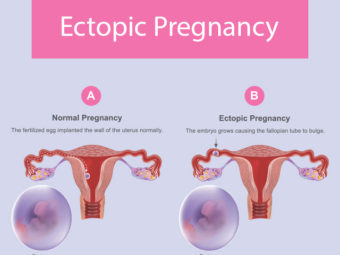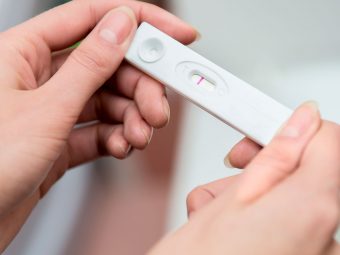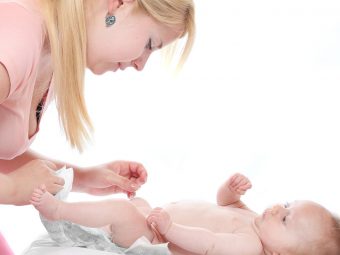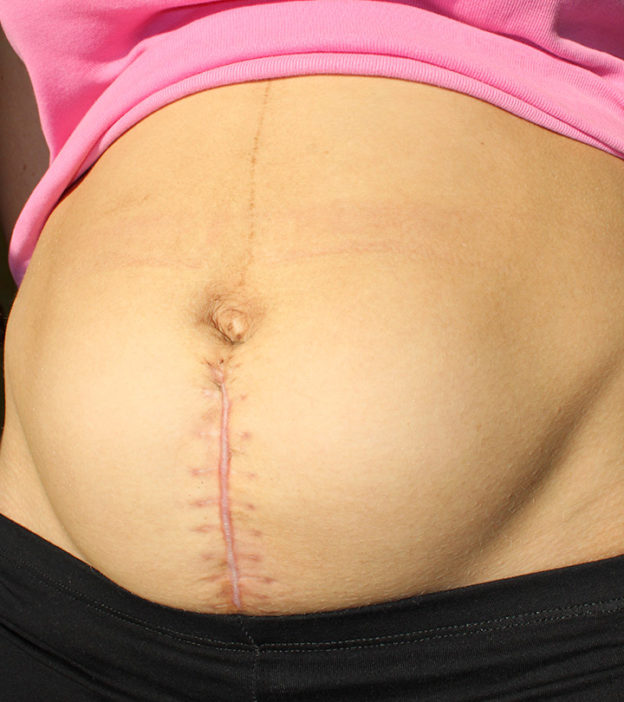
Image: iStock
“How many C-sections can you have?” is a common question many parents may have when the obstetrician suggests a C-section delivery, especially if they would like to have more children.However, it is difficult to say how many C-sections you can have since each woman’s risks and complications vary.一般来说,有一个合并的风险增加cations with subsequent C-sections (1).
Read through the post to learn about the safety, advantages, and side effects of repeat C-sections.
When Is A Repeat C-Section Advisable Over A Vaginal Delivery?
Image: Shutterstock
Some of the indicators to go for a repeat cesarean section are (2):
- Previous uterine rupture
- Presence ofclassical cesarean scar
- Placenta previa
- Increased risk ofuterine rupture
- Any coexisting high risk condition in the pregnancy along with a previous cesarean section (eg: twins,pre-eclampsiaiXA severe pregnancy condition of high blood pressure and protein in the urine)
- Having two prior C-sections
Some incisions from a C-section may limit further vaginal birth and indicate a repeat C-section. They are (3):
- ‘J’ or Inverted ‘T’ shaped cesarean incisions
- Low vertical cesarean incisions
- High vertical cesarean incisions
 Point to consider
Point to considerHow Safe Are Repeat C-Sections?
According to the expert advice, there is a high risk associated with more than three C-sections (1).英国妇产科杂志》和Gynecology (BJOG) says five or more cesarean surgeries are associated with increased complications and longer surgery time (4).The study also finds that the associated risks of having three to four repeat C-sections are similar to five to nine repeat C-sections(4).
What Are The Side Effects Of Repeat C-Sections?
In addition to the complications associated with first time C-section, some additional effects of multiple C-sections are (5), (6):
- Prolonged hospitalization time
- Prolonged operation time
- Frequent prenatal medical visits
- Dense adhesions
- Urinary bladder or intestinal injuries
- Placenta previa (the placenta lies in the lower segment of the uterus)
- Abnormal placental invasion (the placenta attaches abnormally to the myometrium inAccretaiXA pregnancy condition in which the placenta is attached too deeply and firmly to the uterus, invades through the myometrium inIncretaiXA pregnancy condition in which the placenta is attached too deeply to the uterine muscle but doesn't pass through the uterine wallor may perforate through the outermost uterine wall of serosa to invade the urinary bladder inPercretaiXA pregnancy condition in which the placenta passes through the uterine wall and may impact the bladders or intestine)
- Due to previous surgical scars, it might be challenging to perform a surgical incision
Image: Shutterstock
- Myometrial thinning
Are There Any Advantages Of Repeat C-Sections?
Image: Shutterstock
Some benefits of multiple C-sections include (7) (8):
- Less anxietysince you are familiar with the procedure.
- Better planningand scope of preparation to avoid a last-minute rush.
- Lower risk ofuterine ruptureas compared to vaginal birth after cesarean delivery (VBAC).
- No need to go throughlabor pain.
- Lower risk of fetal morbidity and mortality
What Are The Factors To Consider For Subsequent Pregnancy After A C-Section?
Some concerns might run in your mind during pregnancy after a C-section. It is important to bring them to your doctor’s notice and get relief from your worries.
Some factors you should consider in consultation with your doctor before a second pregnancy are (9):
- Wait for thescars to healbefore attempting another pregnancy. It may take up to 18 to 24 months to heal the scars completely.
Image: Shutterstock
- Maternal ageis an essential factor in determining a safe delivery. With a higher age, the risks associated with birth also increase.
- A longer gap can reduce the risk associated withplacenta previaandplacental abruptioniXA sudden early separation of the placenta (the organ that provides oxygen and nutrients to the baby) from the uterus.
- A longer gap can help you achieve aVBAC deliveryiXAlso called vaginal birth after cesarean, it refers to vaginal delivery after a previous cesarean deliveryandavoid complicationsfrom multiple C-sections.
According to the national vital statistics report of 2019, 13.8% of births were VBAC (10).VBAC can be practiced with one previous C-section. However, it is not recommended for everyone to have a VBAC. A committee of doctors will decide if you are fit enough to undertake a vaginal delivery.
Frequently Asked Questions
1. Does C-section pooch go away?
A C-section scar may not go away completely but usually lightens over time. However, fat accumulated under the scar can be shed.
2. How do previous C-sections affect future births?
Previous C-sections may affect future delivery outcomes. In a study published in the National Library of Medicine, C-sections have been associated with future pregnancy complications and fertility issues (14).
3. What is more painful: C-section or natural birth?
Natural birth may be more painful than a C-section as the latter is performed after administering anesthesia. However, the recovery from C-section could cause more discomfort than a natural birth.
It is common for couples planning to have more kids to be confused about the number of C-sections they can have. However, the condition for a repeat C-section depends on the safety and the condition of the mother and also the health of the baby. Possible complications associated with having multiple C-section deliveries include increased operating time, potential injuries to the bladder and intestines, and the thinning of the myometrium, among others. Therefore, have detailed conversations with your OB-GYN about the associated risks and complications of undergoing multiple C-sections to make an informed decision.
Infographic: Negative Effects Of Repeated Cesarean Deliveries
A doctor may recommend a cesarean delivery due to several causes, including high-risk pregnancy and preterm birth. However, if you plan to have three or more deliveries through cesarean section, it might result in some downside. The infographic below outlines various possible complications of repeated C-sections.

Illustration: Momjunction Design Team
Get high-quality PDF version by clicking below.
Download Infographic
Key Pointers
- Some C-section incisions may impede future vaginal births and require a repeat C-section.
- Having more than three C-sections poses a significant risk in subsequent births.
- A repeat C-section may necessitate additional surgery time and a longer hospital stay.
- If you had a C-section, wait for the incision to heal and take a long gap before planning your next pregnancy.
References:
- You Asked: How many C-sections can a woman have?
https://vitalrecord.tamhsc.edu/asked-many-c-sections-can-woman/ - Birth After Previous Caesarean Birth.
https://www.rcog.org.uk/globalassets/documents/guidelines/gtg_45.pdf - Multiple C-Sections.
https://healthcare.utah.edu/womenshealth/pregnancy-birth/multiple-c-sections.php - Higher order repeat caesarean sections: how safe are five or more?
https://obgyn.onlinelibrary.wiley.com/doi/abs/10.1111/j.1471-0528.2004.00244.x?sid=nlm%3Apubmed - Is it safe to have multiple repeat cesarean sections? A high volume tertiary care center experience.
https://www.ncbi.nlm.nih.gov/pmc/articles/PMC5673710/ - Repeat cesarean section in subsequent gestation of women from a birth cohort in Brazil.
https://reproductive-health-journal.biomedcentral.com/articles/10.1186/s12978-017-0356-8 - Planning a repeat caesarean birth.
https://www.nct.org.uk/labour-birth/different-types-birth/caesarean-birth/planning-repeat-caesarean-birth - Weighing the Pros and Cons of Planned VBAC and Repeat Cesarean Section.
https://www.lamaze.org/Giving-Birth-with-Confidence/GBWC-Post/weighing-the-pros-and-cons-of-planned-vbac-and-repeat-cesarean-section - Pregnancy and giving birth after a caesarean section.
https://www.tommys.org/pregnancy-information/giving-birth/after-caesarean-section - Births: Final Data for 2019.
https://www.cdc.gov/nchs/data/nvsr/nvsr70/nvsr70-02-508.pdf#tab17 - Vaginal birth after two caesarean sections (VBAC-2)-a systematic review with meta-analysis of success rate and adverse outcomes of VBAC-2 versus VBAC-1 and repeat (third) caesarean sections.
https://pubmed.ncbi.nlm.nih.gov/19781046/ - Incomplete Cesarean Scar Rupture.
https://www.ncbi.nlm.nih.gov/pmc/articles/PMC3719360/ - What About Uterine Scar Ruptures?
https://www.contemporaryobgyn.net/view/what-about-uterine-scar-ruptures - Long-term risks and benefits associated with cesarean delivery for mother, baby, and subsequent pregnancies: Systematic review and meta-analysis.
https://www.ncbi.nlm.nih.gov/pmc/articles/PMC5779640/











